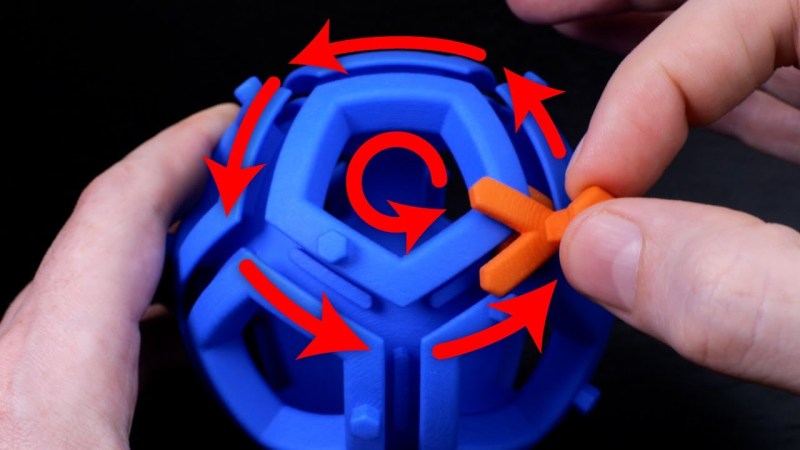3D printers have made a lot of things possible that were either extremely difficult or downright impossible with traditional tooling. Certain shapes lend themselves to 3D printing, and materials and tooling costs are also generally greatly reduced as well. One thing that may not be touched on as often, though, is their ability to rapidly prototype solutions to complex mathematical problems, in this case taking the form of a 3D printed maze, known as a dodecahedral holonomy maze, with an interesting solution.
The puzzle presents itself as a sphere composed of various inlaid hexagons which form a track for the puzzle piece, or “rook”. The tracks create the maze for the rook to travel, as some paths are blocked when the rook is oriented in certain ways. To solve the puzzle, the player must rotate the rook by moving it around the hexagons in such a way that its path isn’t physically blocked by any of the pegs in order to successfully reach the exit. This might seem like a fun toy to have on its surface, but the impressive thing about this is that the solutions are designed to reduce the likelihood of solving the puzzle with any “brute force” methods while at the same time having more than one path that will reach the exit as well as several bottlenecks that the puzzle solver must traverse as well.
There are actually many possible puzzles that can be produced in this size and shape, and all have predetermined solutions with cleverly chosen paths. This might seem like a lot but when you realize that the entire build from concept to 3D modeling to implementation was done by [Henry Segerman] and a group of other mathematicians at Oklahoma State University it starts to become more clear how the puzzle was so well-designed. In fact, we’ve featured some of his other mathematically-modeled builds in the past as well.
Thanks to [Inne] for the tip!
















No Wumpus?
I hate dodecahedrons. They’re the marvel comics of 3d shapes. The puzzle looks interesting, however. I may have to print one myself.
Hexagons? Then the dodecahedron wouldn’t close! Ever!
Yes, that’s an appalling geometric mistake.
Count again: it are pentagons, not hexagons. Fun fact: with only hexagons you can make a flat plane. You need to introduce 12 pentagons to be able to make a closed surface. For instance a soccer ball: white patches are the hexagons, black are the 12 pentagons. A dodecahedron has all hexagons removed.
Interesting puzzle !
You can cover a sphere with any number of hexagons, as long as you have (IIRC) two pentagons and don’t care if the hexagons are all regular. Another way to do it is how Jack L. Chalker laid out the hexes on his Wellworld. Look up imaged of wellworld map.
You need twelve pentagons, not two.
Thanks for the article. Are the cad or slt filed available, to print it myself? I only found a link to shapeways.
No free files it looks like. Almost an advertisement for selling these products. Pretty cool though!
Yeah, while Henry Segerman does make a bunch of his things available for free on Thingiverse, this isn’t one of them. In the comments on the video, he gives two reasons why. First, he’s worried the print quality from a personal FFF print (as opposed to Shapeways’ SLS print) wouldn’t be good enough for it to work well with the moving part. Second, he doesn’t want others to be able to exploit the commercial potential of it so easily.